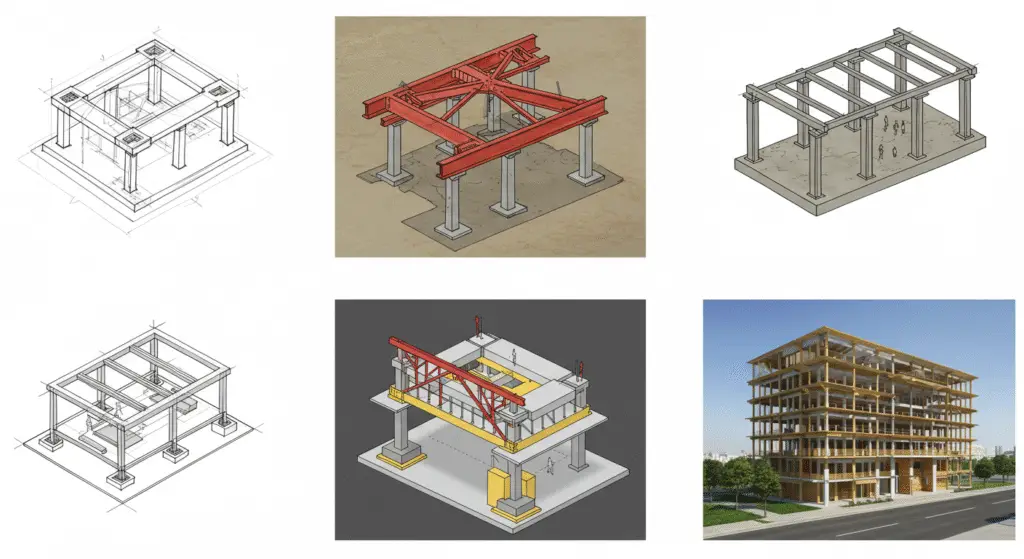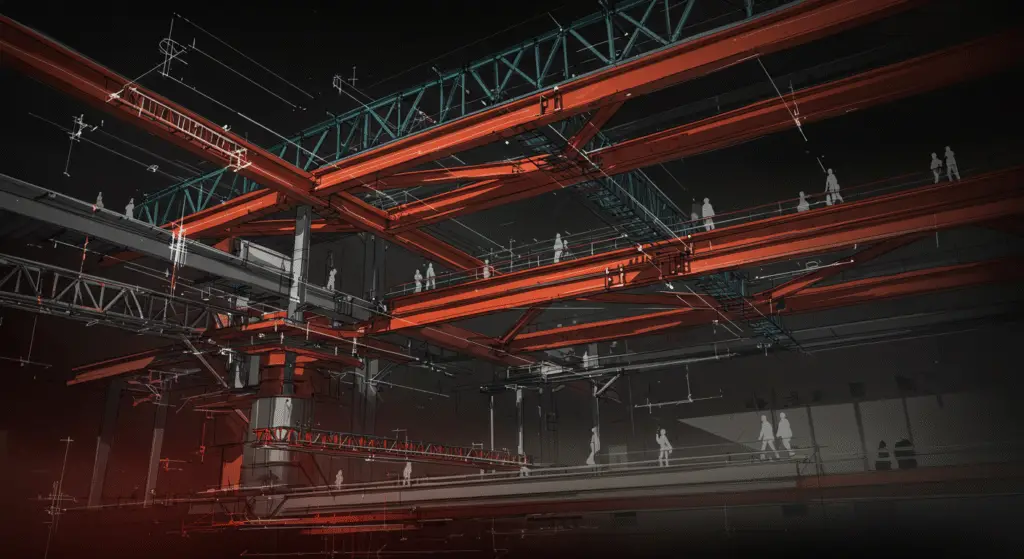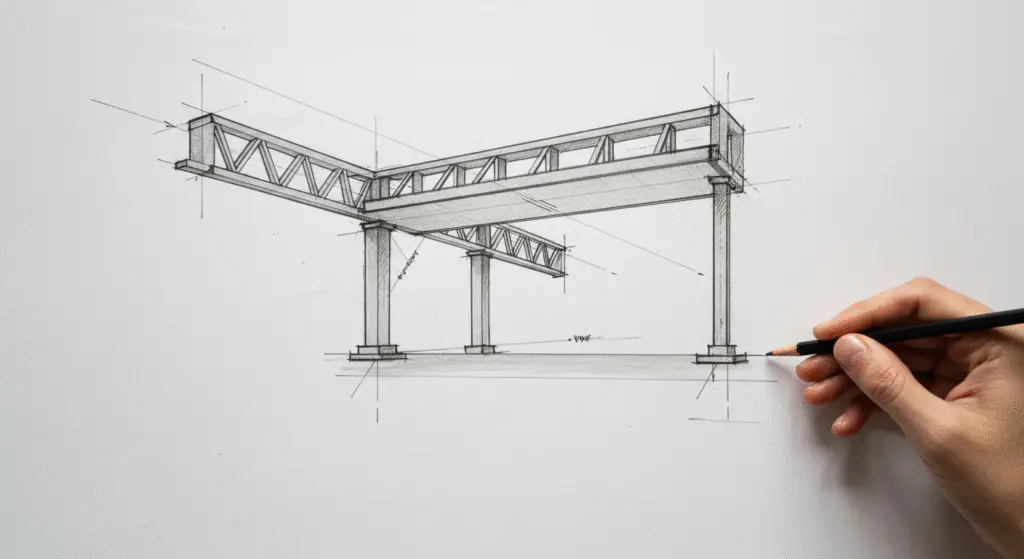What are the 5 stages of structural design?, How to structural design works

Structural design, a crucial component of the broader field of engineering, is the process of conceiving, analyzing, and optimizing the physical frameworks that support and enable the built environment. From the towering skyscrapers that define our urban landscapes to the intricate networks of bridges and highways that connect communities, the structural design process is the foundation upon which these essential structures are realized.
At the heart of structural design lies a methodical, multi-stage approach that guides engineers through the complex challenges and decisions inherent in the creation of safe, functional, and efficient structures. This process, which typically encompasses five distinct stages, requires the integration of technical expertise, creative problem-solving, and a deep understanding of the principles that govern the behavior of materials and the forces that act upon them.
In this comprehensive article, we will delve into the five essential stages of structural design, exploring the unique objectives, considerations, and techniques that define each phase. By understanding the nuances of this process, we can gain valuable insights into the critical role that structural engineers play in shaping the physical world around us, and the ways in which they translate their technical knowledge into tangible, real-world solutions.
Stage 1: Conceptual Design

The initial stage of the structural design process, known as conceptual design, is a crucial step in the translation of an architectural vision into a functional, structurally sound reality. During this phase, structural engineers work closely with architects, urban planners, and other stakeholders to develop the overarching form, layout, and primary load-bearing systems of a proposed structure, laying the foundation for the more detailed design and analysis that will follow.
At the core of the conceptual design stage is the identification and evaluation of the key functional and performance requirements of the structure, which may include factors such as the intended use, occupancy load, and environmental conditions. Structural engineers must also consider the broader context of the project, including site constraints, zoning regulations, and the integration of the structure with its surrounding built environment.
One of the primary objectives of the conceptual design stage is to explore a range of potential structural systems and configurations that can effectively address these requirements, balancing considerations of safety, efficiency, and aesthetics. This may involve the use of sketches, scale models, and conceptual analysis to test the viability and performance of different approaches, ultimately leading to the selection of the most appropriate structural system for the project.
For example, in the design of a high-rise office building, the conceptual design stage might involve the evaluation of various framing systems, such as steel moment frames, concrete shear walls, or a combination of both, to determine the most suitable approach for supporting the building’s weight, resisting lateral loads (such as wind and seismic forces), and accommodating the intended floor plans and interior layouts.
During this phase, structural engineers may also collaborate with architects to explore how the chosen structural system can be integrated with the building’s architectural features, ensuring that the final design not only meets the necessary performance criteria but also aligns with the aesthetic vision and functional requirements of the project.
The conceptual design stage is a critical juncture in the structural design process, as the decisions made here will have a profound impact on the subsequent stages of analysis, detailed design, and construction. By carefully considering the multifaceted requirements and constraints of the project, structural engineers can lay the groundwork for a successful and innovative design that balances technical expertise with creative problem-solving.
Stage 2: Preliminary Design]

Once the conceptual design has been established, the structural design process moves on to the preliminary design stage, where engineers delve deeper into the technical details and computational analysis required to refine and validate the proposed structural system.
During this phase, structural engineers employ a range of analytical tools and techniques to model the behavior of the structure under various loading conditions, including gravity loads, wind, seismic activity, and other environmental factors. This may involve the use of advanced computational software, such as finite element analysis (FEA) programs, to simulate the stresses, deformations, and overall performance of the structure, ensuring that it meets the necessary safety and serviceability requirements.
One of the key objectives of the preliminary design stage is to determine the appropriate size, material, and configuration of the structure’s load-bearing components, such as beams, columns, and foundations. Structural engineers must carefully analyze the anticipated loads and stresses acting on these elements, drawing upon their expertise in structural mechanics, materials science, and design codes to optimize the design and ensure the overall integrity of the structure.
For example, in the design of a bridge, the preliminary design stage might involve the use of computational modeling to evaluate the behavior of the bridge’s deck, girders, and piers under the combined effects of vehicular loads, wind, and environmental factors. Based on these analyses, structural engineers would then proceed to select the appropriate materials (such as steel, concrete, or a composite system) and configure the structural elements to create a design that meets the necessary safety, serviceability, and constructability requirements.
In addition to the technical analysis and design of the structure’s load-bearing components, the preliminary design stage also involves the consideration of broader project-related factors, such as constructability, cost-effectiveness, and sustainability. Structural engineers must work closely with construction managers, cost estimators, and other stakeholders to ensure that the proposed design can be efficiently and economically implemented, while also minimizing the environmental impact and maximizing the long-term performance of the structure.
The preliminary design stage is a critical juncture in the structural design process, as it provides the foundation for the more detailed and refined design that will follow. By thoroughly analyzing the structure’s behavior, optimizing the design of its individual components, and considering the broader project-related factors, structural engineers can develop a robust and well-informed preliminary design that serves as the basis for the final, detailed design.
Stage 3: Detailed Design
With the conceptual and preliminary design stages complete, the structural design process moves on to the detailed design phase, where engineers delve deeper into the intricate technical aspects of the structure, refining and finalizing the design to ensure its safety, functionality, and constructability.
During this stage, structural engineers employ a wide range of analytical techniques and design methodologies to precisely specify the size, configuration, and material properties of each structural element, ensuring that the overall design meets or exceeds the applicable building codes, industry standards, and project-specific requirements.
One of the primary objectives of the detailed design stage is to finalize the design of the structure’s load-bearing components, such as beams, columns, foundations, and connections. This may involve the use of advanced computational tools to model the behavior of these elements under a variety of loading conditions, including static, dynamic, and seismic loads, to determine the appropriate sizing, reinforcement, and detailing required to ensure their structural integrity.
For example, in the design of a multi-story building, the detailed design stage might involve the use of finite element analysis to evaluate the performance of the building’s reinforced concrete shear walls under lateral wind and seismic loads, leading to the specification of the wall thickness, reinforcement layout, and connection details required to meet the necessary safety and serviceability criteria.
In addition to the design of the primary structural elements, the detailed design stage also encompasses the development of the structure’s secondary systems, such as floor and roof systems, stairwells, and elevator shafts. Structural engineers must carefully integrate these components into the overall design, ensuring that they not only support the building’s loads but also align with the architectural layout and functional requirements of the project.
Throughout the detailed design stage, structural engineers must also address a wide range of practical and constructability considerations, such as the availability and properties of construction materials, the feasibility of the proposed erection sequence, and the coordination of the structural design with the work of other disciplines, such as mechanical, electrical, and plumbing systems.
By meticulously addressing these technical details and constructability concerns, structural engineers can develop a comprehensive, well-coordinated design that not only satisfies the structural performance requirements but also facilitates the efficient and cost-effective construction of the project.
The detailed design stage is a critical juncture in the structural design process, as it represents the culmination of the conceptual and preliminary design efforts, resulting in a finalized set of plans, specifications, and calculations that can be used to guide the construction of the structure. Through their rigorous analysis, meticulous design, and close collaboration with other project stakeholders, structural engineers play a pivotal role in ensuring the safety, functionality, and long-term performance of the built environment.
Stage 4: Construction Documents
Following the completion of the detailed design stage, the structural design process moves on to the creation of construction documents, a comprehensive set of drawings, specifications, and supporting information that serve as the blueprint for the actual construction of the structure.
The primary objective of the construction documents stage is to provide a clear, unambiguous, and well-coordinated set of instructions and requirements that can be used by construction contractors, subcontractors, and other project stakeholders to effectively and efficiently execute the construction of the structure.
At the core of the construction documents are the structural drawings, which typically include plans, elevations, sections, and details that precisely depict the size, configuration, and material specifications of the structure’s load-bearing components, such as beams, columns, foundations, and connections. These drawings are typically produced using computer-aided design (CAD) software, allowing for the integration of the structural design with the architectural and other engineering disciplines involved in the project.
In addition to the structural drawings, the construction documents also include a comprehensive set of written specifications that provide detailed information on the materials, construction methods, and quality control requirements that must be adhered to during the construction process. These specifications cover a wide range of topics, from the type and grade of concrete or steel to the installation procedures for various structural components and connection details.
The construction documents stage also involves the development of supporting information, such as load calculations, design assumptions, and material properties, which provide the necessary technical justification and background for the structural design decisions made throughout the previous stages of the process.
Throughout the construction documents stage, structural engineers work closely with the project’s construction team, including general contractors, subcontractors, and inspectors, to ensure that the design intent is clearly communicated and that the structure can be built in accordance with the specified requirements. This may involve the provision of clarifications, revisions, and supplementary information as needed to address any questions or issues that arise during the construction process.
The construction documents stage is a critical step in the structural design process, as it serves as the bridge between the design phase and the actual physical construction of the structure. By providing a comprehensive and well-coordinated set of instructions and requirements, structural engineers can help to ensure the successful and compliant execution of the project, ultimately contributing to the safety, functionality, and long-term performance of the built environment.
Stage 5: Construction Administration
The final stage of the structural design process is construction administration, where structural engineers play a pivotal role in overseeing and supporting the physical construction of the structure, ensuring that the design intent is effectively translated into reality.
During this stage, structural engineers work closely with the construction team, including general contractors, subcontractors, and inspectors, to provide technical guidance, review submittals and shop drawings, and monitor the construction process to ensure compliance with the approved construction documents.
One of the primary responsibilities of structural engineers during the construction administration stage is the review and approval of shop drawings, which are detailed fabrication and installation drawings prepared by the construction team. These drawings, which depict the specific dimensions, configurations, and installation procedures for various structural components, must be carefully reviewed by structural engineers to verify that they align with the design intent and meet the necessary safety and performance requirements.
In addition to the review of shop drawings, structural engineers may also be called upon to provide clarifications, interpretations, or revisions to the construction documents as needed to address any issues or questions that arise during the construction process. This may involve the development of supplementary drawings, details, or specifications to address unforeseen site conditions, changes in the construction sequence, or other project-related factors.
During the construction phase, structural engineers may also be responsible for conducting periodic site visits and inspections to monitor the quality of the construction work and ensure that the structure is being built in accordance with the approved design. This may include the observation of critical construction activities, such as the placement of reinforcement, the pouring of concrete, or the erection of structural steel, to verify that the work is being performed properly and that the structural integrity of the building is being maintained.
In addition to their technical responsibilities, structural engineers may also play a role in the coordination of the construction process, working closely with the project management team to address any scheduling, logistical, or budgetary concerns that may arise during the construction phase.
The construction administration stage is a crucial component of the structural design process, as it ensures that the design intent is effectively translated into a physical structure that meets the necessary safety, functionality, and performance requirements. By providing technical guidance, oversight, and coordination throughout the construction process, structural engineers play a vital role in the successful delivery of the project, contributing to the overall quality, safety, and long-term durability of the built environment.
The Structural Design Process: A Collaborative, Iterative Approach
The five stages of the structural design process – conceptual design, preliminary design, detailed design, construction documents, and construction administration – represent a comprehensive, collaborative, and iterative approach to the creation of safe, functional, and efficient structures.
Throughout each stage, structural engineers must draw upon their technical expertise, problem-solving skills, and commitment to public safety to navigate the complex challenges and constraints that arise, collaborating with architects, construction professionals, and other stakeholders to develop innovative solutions that meet the unique requirements of each project.
By understanding the nuances of this process, we can gain valuable insights into the critical role that structural engineers play in shaping the physical world around us, and the ways in which they translate their technical knowledge into tangible, real-world solutions that enhance the safety, functionality, and sustainability of the built environment.
Whether designing the load-bearing frameworks of a towering skyscraper, developing the intricate structural systems that support a vital transportation network, or ensuring the integrity of the facilities that provide essential services to our communities, structural engineers are the unsung heroes who play a pivotal role in the development and maintenance of the infrastructure that sustains our modern societies.
As the world continues to grapple with the evolving challenges of urbanization, climate change, and the growing demand for resilient, environmentally responsible infrastructure, the importance of the structural design process will only become more critical. By embracing the latest advancements in materials science, computational modeling, and construction techniques, structural engineers will continue to push the boundaries of what is possible, driving progress and innovation in the field of civil engineering and shaping the future of the built environment for generations to come.

What are the 5 stages of structural design?
Five essential stages of structural design, exploring the unique objectives, considerations, and techniques that define each phase.
How to structural design works
Structural design is the backbone of the built environment, responsible for shaping the frameworks and load-bearing systems that support the bridges, buildings, and infrastructure that define our cities and communities. But how exactly does this critical process work?
At its core, structural design is a methodical, multi-stage approach that guides engineers through the complex challenges of creating safe, functional, and efficient structures. This process typically involves five key stages, each with its own unique objectives and considerations.
The first stage is conceptual design, where structural engineers work closely with architects and other stakeholders to develop the overarching form, layout, and primary load-bearing systems of a proposed structure. During this phase, engineers explore various structural systems and configurations, evaluating their viability in terms of safety, efficiency, and aesthetics.
Next comes the preliminary design stage, where engineers delve deeper into the technical details and computational analysis required to refine and validate the structural system. Using advanced software and modeling techniques, they analyze the behavior of the structure under various loading conditions, determining the appropriate size, material, and configuration of the load-bearing components.
With the conceptual and preliminary designs established, the process moves on to the detailed design stage. Here, engineers meticulously specify the design of each structural element, ensuring that the overall system meets or exceeds the applicable building codes, industry standards, and project-specific requirements. This may involve the use of finite element analysis to optimize the performance of critical components like beams, columns, and foundations.
Once the detailed design is complete, the next step is the creation of construction documents – a comprehensive set of drawings, specifications, and supporting information that serve as the blueprint for the physical construction of the structure. These documents provide clear, unambiguous instructions to the construction team, guiding them through the execution of the project.
The final stage of the structural design process is construction administration, where engineers work closely with the construction team to oversee and support the actual building process. This includes reviewing shop drawings, providing technical guidance, and conducting site inspections to ensure the structure is being built in accordance with the approved design.
Throughout each of these stages, structural engineers must draw upon their deep technical expertise, problem-solving skills, and commitment to public safety. They must navigate a complex web of structural mechanics, materials science, and computational analysis, all while collaborating with architects, construction professionals, and other stakeholders to develop innovative solutions that meet the unique requirements of each project.
By understanding the nuances of this intricate process, we can appreciate the vital role that structural engineers play in shaping the built environment. From the towering skyscrapers that define our urban skylines to the bridges that connect our communities, these unsung heroes are the architects of our physical world, translating their technical knowledge into tangible, real-world solutions that enhance the safety, functionality, and sustainability of the structures we rely on every day.
- https://worldcivilsociety.com/how-to-weigh-the-advantages-and-disadvantages-in-structural-engineering/
- https://worldcivilsociety.com/is-structural-engineering-a-good-career/
- https://worldcivilsociety.com/the-backbone-of-engineering-and-how-to-understand-the-importance-of-structures/
- https://worldcivilsociety.com/what-are-the-5-pillars-of-engineering/
Pingback: What are the four types of structures? – worldcivilsociety.com
Pingback: Which Engineering Course is Best? A Comprehensive Guide – worldcivilsociety.com
Pingback: How to Study Civil Drawings: A Comprehensive Guide – worldcivilsociety.com
Pingback: Which Type of Engineering is Best?
Pingback: The Three Main Types of Technical Drawing: A Comprehensive Guide - worldcivilsociety.com
Pingback: What Do Engineers Do? A Comprehensive Overview
Pingback: Biomedical Engineering: A Comprehensive Guide